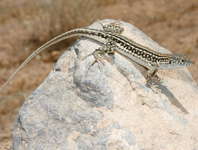Abstract
The nomenclatural status of the Prepuna province sensu Cabrera (1951) and sensu Morrone (1999) is clarified. The Prepuna province sensu Cabrera (1951) is demoted to a district of the Monte province, stat. nov. The valid name of the Prepuna province sensu Morrone (1999) is Cuyan High Andean province Cabrera, 1971, stat. nov. Diagnoses of these areas are provided and their endemic taxa are listed.
References
Aagesen, L., Bena, M.J., Nomdedeu, S., Panizza, A., López, R.P. & Zuloaga, F.O. (2012) Areas of endemism on the southern central Andes. Darwiniana, 50, 218–251.
Aagesen, L., Szumik, C.A., Zuloaga, F.O., & Morrone, O. (2009) Quantitative biogeography in the South America highlands–recognizing the Altoandina, Puna and Prepuna through the study of Poaceae. Cladistics, 25, 295–310.
http://dx.doi.org/10.1111/j.1096-0031.2009.00248.xAbraham, E., del Valle, H.F., Roig, F., Torres, L., Ares, J.O., Coronato, F. & Godagnone, R. (2009)Overview of the geography of the Monte Desert biome (Argentina). Journal of Arid Environments, 73, 144–153.
http://dx.doi.org/10.1016/j.jaridenv.2008.09.028Burkart, R., Bárbaro, N.O., Sánchez, R.O. & Gómez, D.A. (1999) Eco-regiones de la Argentina. Administración de Parques Nacionales, Buenos Aires, pp. 1–43.
Cabrera, A.L. (1951) Territorios fitogeográficos de la República Argentina. Boletín de la Sociedad Argentina de Botánica, 4, 21–65.
Cabrera, A.L. (1971) Fitogeografía de la República Argentina. Boletín de la Sociedad Argentina de Botánica, 14, 1–42.
Cabrera, A.L. (1976) Regiones fitogeográficas argentinas. In: Kugler, W.F. (Ed.), Enciclopedia Argentina de Agricultura y Jardinería. II, ACME, Buenos Aires, pp. 1–85.
Cabrera, A.L. & Willink, A. (1973) Biogeografía de América Latina. Monografía 13, Serie de Biología, OEA, Washington, D.C., 120 pp.
Dinerstein, E., Olson, D.M., Graham, D.J., Webster, A.L., Primm, S.A., Bookbinder, M.P. & Ledec, G. (1995) A conservation assessment of the terrestrial ecoregions of Latin America and the Caribbean. The World Bank, Washington, D.C., 129 pp.
http://dx.doi.org/10.1596/0-8213-3295-3Ebach, M.C., Morrone, J.J., Parenti, L.R. & Viloria, A.L. (2008) International Code of Area Nomenclature. Journal of Biogeography, 35, 1153–1157.
http://dx.doi.org/10.1111/j.1365-2699.2008.01920.xEzcurra, C. (2001) South Andean Steppe. In: Terrestrial Ecoregions of Latin America and the Caribbean, World Wildlife Fund. WWF NT1008. Available from: http://www.worldwildlife.org/ecoregions/nt1008 (accessed 1 March 2016)
Ferro, I. & Bárquez, R.M. (2014) Patrones de distribución de micromamíferos en gradientes altitudinales del noroeste argentino. Revista Mexicana de Biodiversidad, 85, 472–490.
http://dx.doi.org/10.7550/rmb.38029Fittkau, E.J. (1969) The fauna of South America. In: Fittkau, E., Illies, J.J., Klinge, H., Schwabe, G.H. & Sioli, H. (Eds.), Biogeography and ecology in South America, 2. Junk, The Hague, pp. 624–650.
Holmberg, E.L. (1898) La flora de la República Argentina. Segundo Censo de la República Argentina, 1, 385–474.
López, R.P. (2000) La prepuna boliviana. Ecología en Bolivia, 34, 45–65.
Löwenberg-Neto, P. (2014) Neotropical region: A shapefile of Morrone's (2014) biogeographical regionalisation. Zootaxa, 3802 (2), 300.
http://dx.doi.org/10.11646/zootaxa.3802.2.12Löwenberg-Neto, P. (2015) Andean region: A shapefile of Morrone's (2015) biogeographical regionalisation. Zootaxa, 3985 (4), 600.
http://dx.doi.org/10.11646/zootaxa.3985.4.9Morello, J.H. (1958) La provincia fitogeográfica del Monte. Opera Lilloana, 2, 5–115.
Morrone, J.J. (1999) Presentación preliminar de un nuevo esquema biogeográfico de América del Sur. Biogeographica, 75, 1–16.
Morrone, J.J. (2001) Biogeografía de América Latina y el Caribe. Vol. 3. M&T-Manuales & Tesis SEA, Sociedad Entomológica Aragonesa, Zaragoza, 148 pp.
Morrone, J.J. (2014) Biogeographical regionalisation of the Neotropical region. Zootaxa, 3782 (1), 1–110.
http://dx.doi.org/10.11646/zootaxa.3782.1.1Morrone, J.J. (2015) Biogeographical regionalisation of the Andean region. Zootaxa, 3936 (2), 207–236.
http://dx.doi.org/10.11646/zootaxa.3936.2.3Olson, D.M., Dinerstein, E., Wikramanayake, E.D., Burgess, N.D., Powell, G.V.N., Underwood, E.C., D’Amico, J.A., Strand, H.E., Morrison, J.C., Loucks, C.J., Allnutt, T.F., Lamoreux, J.F., Ricketts, T.H., Itoua, I., Wettengel, W.W., Kura, Y., Hedao, P. & Kassem, K. (2001) Terrestrial ecoregions of the world: A new map of life on Earth. BioScience, 51, 933–938.
http://dx.doi.org/10.1641/0006-3568(2001)051[0933:TEOTWA]2.0.CO;2Ribichich, A.M. (2002) El modelo clásico de la fitogeografía de Argentina: Un análisis crítico. Interciencia, 27, 669–675.
Rivas-Martínez, S. & Navarro, G. (1994) Mapa biogeográfico de Suramérica. Published by the authors, Madrid.
Rundel, P.W., Gibson, A.C., Midgley, G.S, Wand, S.J.E., Palma, B., Kleier, C. & Lambrinos, J. (2003) Ecological and ecophysiological patterns in pre-altiplano shrubland of the Andean Cordillera in northern Chile. Plant Ecology, 169, 179–193.
http://dx.doi.org/10.1023/A:1026075721045Udvardy, M.D.F. (1975) A classification of the biogeographical provinces of the world. International Union for Conservation of Nature and Natural Resources Occasional Paper 18, Morges, 49 pp.

